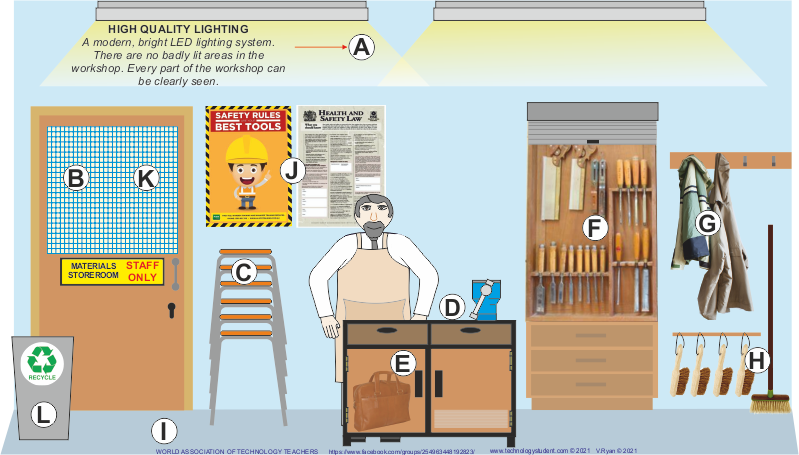| CLICK HERE FOR INDEX PAGE | |
| WHAT IS A SAFE AND WELL ORGANISED WORKSHOP? | |
| V. Ryan © 2003 - 2021 | |
| If a workshop is to be a safe and efficient workplace, it must be well organised and pupils must follow all health and safety guidance / regulations. Good behaviour and a positive attitude to work are also essential. | |
| 1. Study the image of the workshop below. Identify all the safety issues. One safety issue has been identified for you. Can you think of any more safety issues? If you can, draw and describe them on the image. |
|
 |
|
| 2. Study the image of the workshop. Good examples of safety and workshop organisation, are indicated by the letters. Write a description / explanation alongside each letter. One has been completed for you. Can you think of any more good examples of safety and organisation? If you can, draw and describe them on the image. | |
 |
|
| CHARACTERISTICS OF A WELL ORGANISED AND SAFE WORKSHOP | |
A. HIGH STANDARD OF LIGHTING: A workshop must have good lighting. A badly illuminated workshop is dangerous, especially when machines and tools are in use. B. SECURE / LOCKED: Storerooms often have specialised racks and shelving systems, that hold materials, tools and equipment in place. C. STOOLS STACKED: When stools are not in use, they should be stacked away from the work area. Stools left out in the work area, are a trip danger. D. TIDY WORKBENCH: Always keep the workbench clear of tools and equipment, that are not in use. An untidy bench, can result in tools being knocked off the top surface. It is difficult to work efficiently or safely, if your workbench is untidy. E. BAGS STORED IN A CUPBOARD: Bags left out in the work area, are a trip danger. They tend to get in the way of people collecting tools and equipment, from a storage cupboard. F. A WELL ORGANISED TOOL CUPBOARD: When tools are organised and stored properly, they are easy to see and collect. Tools should be put away, when not in use and at the end of the lesson. G. COATS ON HANGERS: Coats should be hung on hangers or stored away from the work area. H. BRUSHES FOR CLEANING THE WORKSHOP: During a practical lesson, there will be times when tidying up is required, keeping the benches and floor clear of debris. An organised workshop, is a tidy workshop. I. NO DEBRIS ON THE FLOOR: Waste materials / off-cuts and dust, should be brushed up from the floor. It is easy to ‘turn’ an ankle or slip, on a small piece of waste material. J. SAFETY POSTERS CLEARLY DISPLAYED: Safety posters should be clearly displayed on the walls. Information should also be posted alongside each machine. This is a legal requirement. K. ‘STAFF ONLY’ AREA CLEARLY INDICATED: There may be a store area or preparation room, joining the workshop. These rooms are for staff only, because of the type of dangerous machine they contain and the storage of materials. L. RECYCLING AND WASTE BINS: Workshop should have at least one bin, for waste material. Some workshops may have recycle bins for a range of materials including plastics, metals and woods. |
|
| EXTENSON WORK ON SAFETY | |
 |
|
|
|
|
|
Ed the Handyman is taking his time. He will clean up the bench tomorrow (possibly) and prefers to drink coffee than leave the bench safe for the next person to use. Ed has left his commonsense at home, yet again. |
|
|
|
|
|
QUESTIONS: 1. What is unsafe about the bench that Ed has finished using? 2. Describe how you intend to leave a workbench after using it. |
|
|
|
|